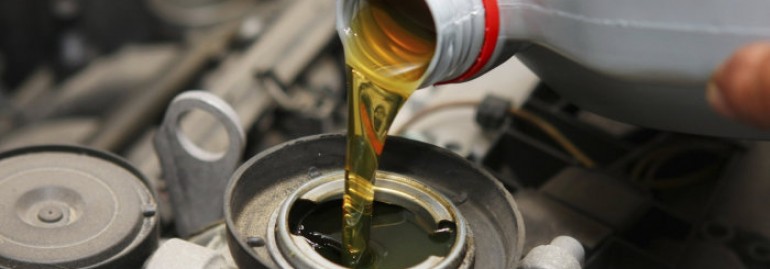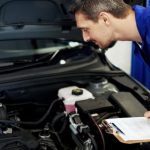If you are a car owner, it is important that you know how to perform some basic maintenance. The first step is learning various parts and their functions. By performing the maintenance yourself, you will save money and also enjoy the satisfaction of knowing that your vehicle is in peak operating condition. Here’s a listing of car maintenance tips and when to do them.
- Every time you fill up your gas tank:
- Check the engine oil level and add more if needed. Consult the owner’s manual for the proper viscosity. If your car appears to be losing an abnormal amount of oil (or if you spot leaks on your garage or driveway floor), you may have an engine leak.
- Check the coolant level in the coolant surge tank and add the proper coolant if necessary. The coolant surge tank is typically located on the driver’s side of the engine compartment. Replace the coolant if it is dirty or has a rusty appearance.
- For further auto maintenance, check the other fluid levels. The reservoirs for all of these fluids should be filled to the top:
- Windshield washer fluid.
- Brake fluid.
- Power steering fluid.
- Every week:
- Inspect your tires. Check your car’s tires for damage, adequate inflation, and wear. Check the tire tread by inserting a penny in the tire grooves (with Lincoln’s head facing the tread) – if you can see the top of Lincoln’s head, then the tread is worn and the tires should be replaced. If the tires need air, inflate them to the required pressure per the car owner’s manual. If you don’t have your owner’s manual, look for the manufacturer’s information label inside of the car– it can often be found inside the driver’s side door or printed inside the glove box. If your tires show damage or wear, replace or rotate them as necessary. Don’t forget to check the “Space Saver” spare tire in your car’s trunk for proper inflation as well (and if you don’t already have a spare tire, be sure to get one). Remember, properly inflated tires are a necessity for safe driving and they can also help your car achieve better gas mileage. I bet that got your attention!
- At least every month:
- Check that all of your interior and
 exterior lights are working. These include the license plate light, side marker lights, headlights (including the high beams), parking lights, tail lights, brake lights, turn signal lights, reverse lights, instrument panel lights, and hazard warning flasher. If any of these lights are not working, replace the bulbs right away. Defective lights, especially faulty turn signal and brake lights, can be hazardous – and can also result in you getting ticketed.
exterior lights are working. These include the license plate light, side marker lights, headlights (including the high beams), parking lights, tail lights, brake lights, turn signal lights, reverse lights, instrument panel lights, and hazard warning flasher. If any of these lights are not working, replace the bulbs right away. Defective lights, especially faulty turn signal and brake lights, can be hazardous – and can also result in you getting ticketed.
- Every 3000 miles:
- Change your oil. Car manufacturers generally recommend that you change your engine oil and filter every 3,000 miles. To change your own oil, you will need the following tools: socket wrench, oil filter wrench, drain pan, 4 quarts of oil (5W30 or 10W30, depending on your car type), oil filter, and a drain plug gasket. You will also need car ramps to raise your car up so that you can get underneath it. Once your car is jacked up, you should remove the drain plug using your socket wrench and drain out the old oil into the drain pan. When all of the oil is drained out, remove the old gasket from the drain plug and replace it with a new gasket before screwing in the plug. Next you’ll remove the old oil filter using your oil filter wrench. Be aware that some residual oil will drain out into your drain pan. Lube the rubber O-ring on your new oil filter and tighten it hand tight – don’t use the wrench because you may over-tighten the filter. Use a rag to wipe up any spilled oil, collect all of your tools along with the used oil, and clear out from under the car. The last step is to add your new oil by removing the oil fill cap in the top of the engine and pouring in 4 quarts of fresh oil. Once you’ve done your first oil change, it will get easier and faster each time you do it.
- Rotate your tires. At this time it is also a good idea to rotate your car tires. While you have the wheels removed, you should check the brake systems for the following:
- Lines and hoses for proper installation, binding, leaks, cracks, and chafing.
- Disc brake pads for wear and rotors for surface wear.
- Drum brake linings for wear and cracks.
- Parking brake adjuster for the need to tighten the cable.
- Check transaxle fluid. At this time you should also check your transaxle fluid level (manual and automatic). The transaxle fluid dipstick is usually found near the rear of the engine compartment. Check the levels and add the proper fluid as needed (the dipstick usually has indentations that indicate where the fluid level should be). Be aware that fluid loss may indicate a problem, so check the system and repair as necessary.
- At least twice a year:
- Check all window wipers. Check the wipers both on the front windshield and also on the back window. If you notice any deterioration in the rubber, replace all of the blades at the same time.
- Finally, always be sure to keep engine oils, coolant, all other fluids and other car maintenance supplies tightly sealed and out of reach of small children and animals. Be sure to wipe up all spills and dispose of used materials properly.
Car Maintenance Tips & Tricks: Car Tires, Parts and Oil Change
4.3 (86.15%)
13 votes



 exterior lights are working. These include the license plate light, side marker lights, headlights (including the high beams), parking lights, tail lights, brake lights, turn signal lights, reverse lights, instrument panel lights, and hazard warning flasher. If any of these lights are not working, replace the bulbs right away. Defective lights, especially faulty turn signal and brake lights, can be hazardous – and can also result in you getting ticketed.
exterior lights are working. These include the license plate light, side marker lights, headlights (including the high beams), parking lights, tail lights, brake lights, turn signal lights, reverse lights, instrument panel lights, and hazard warning flasher. If any of these lights are not working, replace the bulbs right away. Defective lights, especially faulty turn signal and brake lights, can be hazardous – and can also result in you getting ticketed.


Thank you for mentioning the importance of checking the tires every week. I feel like the heat and rough road work in my city has taken its toll on my car recently, and I wouldn’t want this to lead me into having an accident. My tires haven’t been checked in a long while, so I’ll take your advice and look for an auto service to inspect my tires and see if the recent conditions have done anything to them.